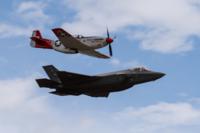The United States currently uses 11 nuclear-powered aircraft carriers to project global power, so it might be hard to imagine it having 151 carriers during World War II.
If the U.S. had that many modern carriers, it could probably take on the entire world. But naval warfare was very different back then. Fighting WWII meant the Navy not only had to build enough ships to beat the Japanese, but also to replace its losses.
Losing a carrier isn't something that really happens anymore. And losing a Casablanca-class escort carrier like the USS Bismarck Sea to the enemy can't compare to losing the USS Gerald R. Ford, the Navy's largest and most advanced carrier to date.
Still, when the USS Bismarck Sea was sunk by Japanese kamikaze pilots during the Battle of Iwo Jima in 1945, she took 318 crewmen down with her, a devastating loss.
Twelve aircraft carriers were sunk by the enemy during World War II -- five fleet carriers, a seaplane tender and six escort carriers. The loss of the Bismarck Sea was the last time that a U.S. carrier went down due to enemy action.
The United States built 50 Casablanca-class carriers during the war, but they were nothing like the floating cities of today. Ships like the Bismarck Sea were around one-tenth the size of the Ford class, so a large number of ships was vital to the Pacific War effort.
The ship was named for the Battle of the Bismarck Sea, a lopsided 1943 win for the Allies that kept the Japanese from reinforcing its troops on Papua New Guinea and may have prevented the capture of the island altogether.
When first launched in April 1944, the ship was called the Alikula Bay. The rules on ship naming changed soon after. Originally, escort carriers were named after Alaskan bays, but a new policy decided they would be named after military engagements. A month after launch, the ship was renamed the Bismarck Sea.
If the old sailor's superstition warning against renaming a boat is true, it didn't apply to the Bismarck Sea -- at least, not right away. The ship earned three battle stars in support of the Philippines Campaign off Mindanao, Leyte and Luzon. It also helped move the first wave of invaders ashore at Iwo Jima.

The ship met its fate at the hands of two incredibly lucky kamikaze hits at Iwo Jima. The first plane came in the early evening, flying so low that the ship's guns couldn't hit it. It struck the ship's magazine, spilling weapons and ammo, from bullets to torpedoes, everywhere.
As the plane hit the carrier, the ship's elevator was moving up. The platform dropped, causing an explosion that crippled the ship's ability to steer. It also started a fire that blazed into the night.
Twenty minutes after the first plane hit, the captain gave the order to abandon ship.
As the sun went down, the burning carrier made a tempting target. A second plane hit the ship, making it impossible for the crew to fight the fire. It struck an area that housed four fully fueled fighter planes, turning half the ship into a fireball.
But the disaster didn't end there. The fire in the magazine finally blew the weapons as the crew disembarked, and the ship began to list. Two hours after the initial kamikaze hit, the ship was on its way to the bottom, taking 318 American sailors with it. An estimated 605 were rescued from the water.
It was the last time an aircraft carrier was sunk during World War II, and the last time a commissioned American carrier was sunk by an enemy action.
In 1964, Viet Cong commandos managed to strap explosives to the USNS Card, a decommissioned carrier used by the Navy with a civilian crew aboard. The resulting attack punched a hole in the hull and sank the Card 48 feet to the bottom of the Saigon port. But the ship was soon lifted and sent to the Philippines for repairs.
-- Blake Stilwell can be reached at blake.stilwell@military.com. He can also be found on Twitter @blakestilwell or on Facebook.
Want to Learn More About Military Life?
Whether you're thinking of joining the military, looking for post-military careers or keeping up with military life and benefits, Military.com has you covered. Subscribe to Military.com to have military news, updates and resources delivered directly to your inbox.
















